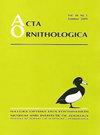Monitoring the Hatching Success of Gulls Laridae and Terns Sternidae: A Comparison of Ground and Drone Methods
IF 1.3
4区 生物学
Q3 ORNITHOLOGY
引用次数: 4
Abstract
Abstract. Measuring the productivity of gulls Laridae and terns Sternidae is often difficult, due to natural obstacles of site access and the need to avoid disturbing nesting birds. Drones are increasingly being used for conservational and ecological applications and their use seems to overcome these problems, but data are still scarce on their use to assess breeding success. Our objective was to compare the effectiveness, time consumption, and safety for birds of drone-conducted monitoring of nest-specific hatching success with usual ground surveys of two species of gulls, including Slender-billed Gulls Chroicocephalus genei and Mediterranean Gulls Larus melanocephalus, and two species of terns, including Gull-billed Terns Gelochelidon nilotica and Sandwich Terns Thalasseus sandvicensis, breeding in the Adriatic wetlands of northeast Italy. We studied 400 nests (100 per species distributed in eight plots, each with 50 nests) and found no significant difference between the two methods in determining the number of eggs either laid or hatched per nest for all four focal species. The average coefficient of agreement between methods was high (kappa > 0.80 for all comparisons). The mean time spent determining the hatching success of 50 clutches with a drone (263 sec per plot) was significantly less than with ground surveys (760 sec per plot). There were no apparent negative effects of drone flights on nesting pairs, clutches, or young. Our results suggest that drones allow effective, rapid, and safe measurement of seabird breeding success in coastal areas.地面和无人机孵化成功率监测方法的比较
摘要测量海鸥科和燕鸥科的生产力通常是困难的,因为进入地点的自然障碍和需要避免打扰筑巢的鸟类。无人机越来越多地用于保护和生态应用,它们的使用似乎克服了这些问题,但使用它们来评估繁殖成功的数据仍然很少。本研究的目的是比较无人机监测鸟类特定巢孵化成功率与常规地面调查的有效性、耗时和安全性,其中包括长嘴鸥(chricocephalus geni)和地中海鸥(Larus melanocephalus),以及意大利东北部亚得里亚海湿地繁殖的两种燕鸥(Gelochelidon nilotica)和三文鸥(Sandwich terns Thalasseus sandvicensis)。我们研究了400个巢(每个物种100个,分布在8个样地,每个样地有50个巢),发现两种方法在确定所有4种焦点物种的每个巢的产卵或孵化数量方面没有显著差异。方法间的平均一致系数较高(所有比较kappa > 0.80)。用无人机确定50个卵的孵化成功率的平均时间(每地块263秒)明显少于地面调查(每地块760秒)。无人机飞行对巢对、窝或幼鸟没有明显的负面影响。我们的研究结果表明,无人机可以有效、快速、安全地测量沿海地区海鸟的繁殖成功率。
本文章由计算机程序翻译,如有差异,请以英文原文为准。
求助全文
约1分钟内获得全文
求助全文
来源期刊

Acta Ornithologica
生物-鸟类学
CiteScore
2.10
自引率
0.00%
发文量
14
审稿时长
>12 weeks
期刊介绍:
Publishes scientific papers (original research reports, reviews, short notes, etc.) and announcements from all fields of ornithology. All manuscripts are peer-reviewed.
Established in 1933 as Acta Ornithologica Musei Zoologici Polonici, since 1953 continued under the present title.
Published twice a year by the Natura Optima Dux Foundation under the auspices of the Museum and Institute of Zoology, Polish Academy of Sciences.
 求助内容:
求助内容: 应助结果提醒方式:
应助结果提醒方式:


